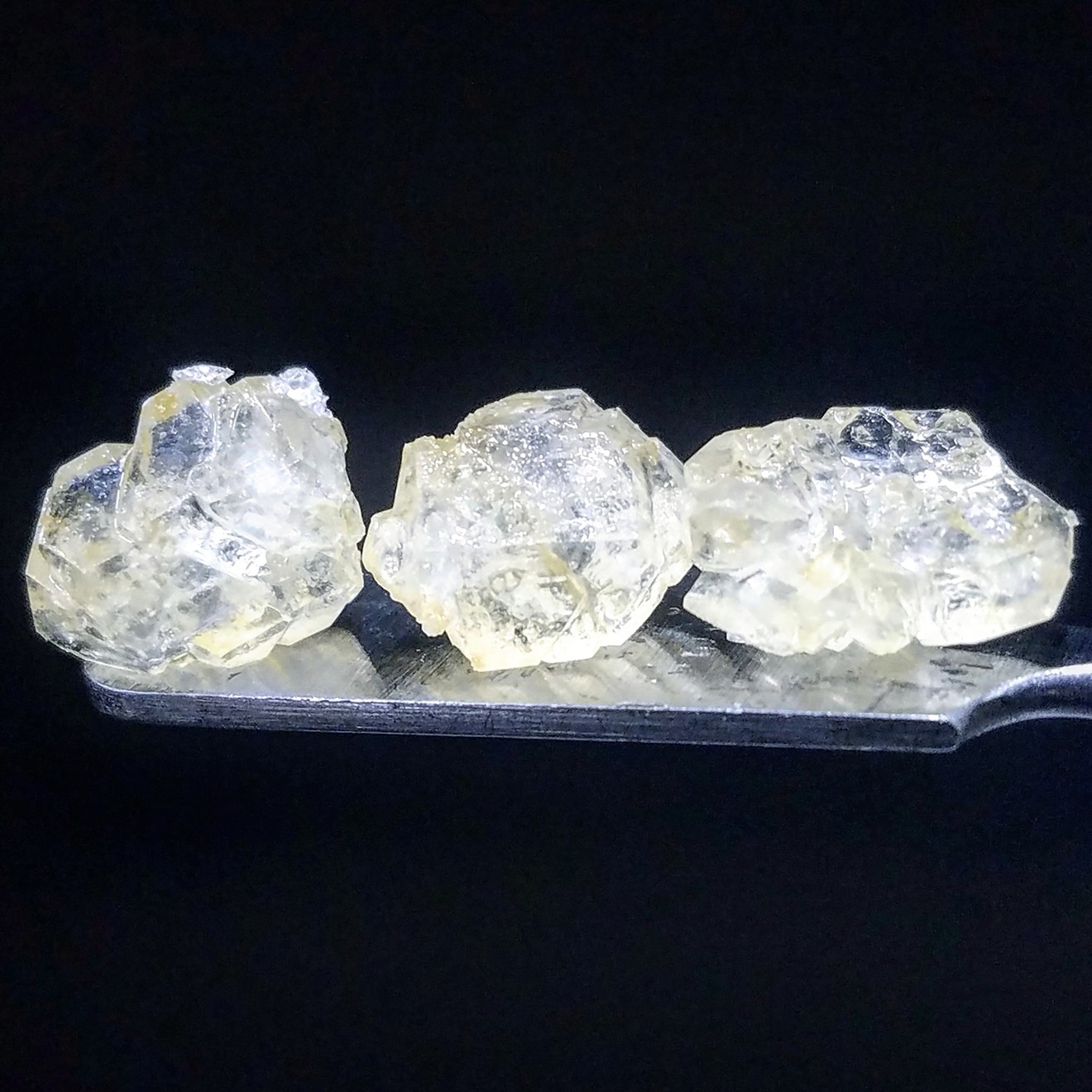If you haven’t heard about THCA diamond, don’t feel out of the loop. For now, the relatively new cannabis concentrate seems about as rare as its geological counterpart.
Diamond began showing up in the Arizona medical-marijuana market around mid-2017. Only three labs in Arizona produce the “super concentrate:” Tru|med’s Drip Oils + Extracts, Item 9 Labs, and MPX.
THCA is THC acid. It’s a precursor to THC sometimes used in topicals and other concentrate forms and doesn’t produce the same psychoactive effects as THC. Cannabis doesn’t start making THC until its THCA is exposed to heat, like sunlight or the flame from a lighter.
The idea behind pure THCA concentrate is that it gives patients the option to inhale nearly pure THC. Most concentrates, like shatter and vape pen oil, hover in the 70 to 90 percent THC range.
Many patients may consume diamond by itself; many choose to add it to blunts or bowls to increase THC consumption. Drip Oil’s lab director, Jared Priset said it’s a prime ingredient in “caviar,” a bud doused in butane hash oil and rolled around in kief.
Priset likens it to an ingredient in a salad. Some products offer patients something more like a premade salad mix, he explained, but with different cannabinoid and terpene isolates now available, patients can customize what molecules they’re consuming with greater precision.
Priset first came across diamond at the 2015 High Times Cup in California. He began working on his own formula at Drip in late 2016. Tru|med’s Black Diamond THCA won second place at the Errl Cup in January.
It took Priset a couple months of trial and error to dial in a process that produced pure enough crystals that he felt good about putting on shop shelves.
“It’s one of those things where you keep exploring and keep advancing the techniques,” he said.
The first batch came from a secondary extraction, Priset said. That is, the resin is extracted from the plant, and the THCA extracted from the resin. But now, it has its own extraction method.
It begins where most concentrates begin, from a slurry of plant material dissolving in butane solvent. First, hexane or acetic acid is added to the mixture to further separate the plant material.
Once the plant material is filtered out, a pure mix of cannabinoids and terpenes are put in a rotary evaporator, also aptly named a “diamond miner.”
The diamond miner uses heat and pressure to form delta-9 THCA crystals beneath liquified terpenes. That “sauce” is separated and used as its own product or added into others, Priset explained. The crystals are put back in the diamond miner for one more bake, and the result is pure THCA.
Priset gives several reasons for why it’s taken so long for diamond to show up on the market.
For starters, there’s a lot more cannabis to “play with” these days, he said.
“That’s allowed for a little more R&D and playing with some of the different consistencies,” he said. “There’s a little more freedom for those sort of things.”
The increased quality comes in part as a result of refined cultivation techniques that make it easier to produce diamond. Terpenes themselves can act as a solvent for THCA, so strains with high concentrations of both cannabinoids and terpenes yield better THCA crystals.
While diamond is legal in many states now, Arizona’s not one of them — except for patients. That could change. Though some Arizona medical-marijuana dispensaries now sell diamond, the new concentrate represents (maybe better than others) the type of extract at the center of an upcoming Arizona Supreme Court case.
In State v. Jones, Yavapai County Attorney Sheila Polk hopes to make felons out of patients who use concentrates, and of the dispensaries that make and sell them. Oral arguments in the case are set for next month.
Michigan banned diamond specifically last August. However, the issues raised have been more over concerns of a regulated extraction method than dangers of the substance itself. In places like Seattle, diamond is barely noticed other than by connoisseurs.
[
{
"name": "Air - MediumRectangle - Inline Content - Mobile Display Size",
"component": "18478561",
"insertPoint": "2",
"requiredCountToDisplay": "2"
},{
"name": "Editor Picks",
"component": "16759093",
"insertPoint": "4",
"requiredCountToDisplay": "1"
},{
"name": "Inline Links",
"component": "17980324",
"insertPoint": "8th",
"startingPoint": 8,
"requiredCountToDisplay": "7",
"maxInsertions": 25
},{
"name": "Air - MediumRectangle - Combo - Inline Content",
"component": "16759092",
"insertPoint": "8th",
"startingPoint": 8,
"requiredCountToDisplay": "7",
"maxInsertions": 25
},{
"name": "Inline Links",
"component": "17980324",
"insertPoint": "8th",
"startingPoint": 12,
"requiredCountToDisplay": "11",
"maxInsertions": 24
},{
"name": "Air - Leaderboard Tower - Combo - Inline Content",
"component": "16759094",
"insertPoint": "8th",
"startingPoint": 12,
"requiredCountToDisplay": "11",
"maxInsertions": 24
}
]











